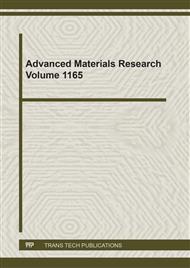[1]
E.J. Pickering, Macrosegregation in steel ingots, The applicability of modeling and characterization techniques, ISIJ Int. 53/6 (2012) 935-949.
DOI: 10.2355/isijinternational.53.935
Google Scholar
[2]
B. Sang, X. Kang, D. Li, A novel technique for reducing macrosegregation in heavy steel ingots, J. Mater. Process. Technol. 210 (2010) 703-711.
DOI: 10.1016/j.jmatprotec.2009.12.010
Google Scholar
[3]
N. Hatami, R. Babaei, M. Dadashzadeh, P. Davami, Modelling of hot tearing formation during solidification, J. Mater. Process. Technol. 205 (2008) 506-513.
DOI: 10.1016/j.jmatprotec.2007.11.260
Google Scholar
[4]
V. Leroy, R. D'Haeyer, J. Defourny, T. Hoogendoorn, J. P. Birat, H. J. Grabke, W. B. Morrison, N. G. Henderson, R. D. Longbottom, T. Laux, I. Les, Effects of tramp elements in long and flat products, Technical Steel Research, Final Report, European Commission, (1995).
Google Scholar
[5]
Y. Nuri, T. Ohashi, T. Hiromoto and O. Kitamura, Solidification macrostructure of ingots and continuously cast slabs treated with rare earth metals, Trans. Iron Steel Inst. Jpn. 22 (1982) 408-416.
DOI: 10.2355/isijinternational1966.22.408
Google Scholar
[6]
L. Wang, Q. Lin, J. Ji, D. Lan, New study concerning development of application of rare earth metals in steels, J. Alloys Comp. 408-412 (2006) 384-386.
DOI: 10.1016/j.jallcom.2005.04.090
Google Scholar
[7]
L. Wang, Q. Lin, L. Yue, L. Liu, F.Guo, F. Wang, Study of application of rare earth elements in advanced low alloy steels, J. Alloys Comp. 451 (2008) 534-537.
DOI: 10.1016/j.jallcom.2007.04.234
Google Scholar
[8]
J. Lan, J. He, W. Ding, Q. Wang, Y. Zhu, Effect of rare earth metals on the microstructure and impact toughness of a cast 0.4C-5Cr-1.2Mo-1.0V steel, ISIJ Int. 40/12 (2000) 1275-1282.
DOI: 10.2355/isijinternational.40.1275
Google Scholar
[9]
M. Andersson, J. Janis, L. Holappa, M. Kiviö, P. Naveau, M. Brandt, D. Espinosa, L. Bellavia, X. Vanden Eynde, E. de Courcy, L. Chapuis, T. Iung, S. Ekerot, C. van der Eijk, Grain size control in steel by means of dispersed non-metallic inclusions – GRAINCONT, Final Report EUR24993EN, Directorate-General for Research, European Commission, (2011).
Google Scholar
[10]
S. Kunstreich (D. Rotelec), Electromagnetic stirring for continuous casting – Part 1, La Rev. Metall. CIT (April 2003) 395-408.
Google Scholar
[11]
N. El-Kaddah, T. T. Natarajan, Electromagnenetic stirring of steel: Effects of stirrer design on mixing in horizontal electromagnetic stirring of steel slabs, Second International Conference on CFD in the Minerals and Process Industries, CSIRO, Melbourne, Australia, 6-8 December 1999, pp.339-344.
Google Scholar
[12]
K-H. Spitzer, M. Dubke, K. Schwerdtfeger, Rotational electromagnetic stirring in continuous castings of round strands, Metall. Trans.B 17B (March 1986) 119-131.
DOI: 10.1007/bf02670825
Google Scholar
[13]
J. W. Morris Jr., Ch. Kinney, K. Pytlewski, Y Adachi, Microstructure and cleavage in lath martensitic steels, Sci. Technol. Adv. Mater. 14 (2013) 014208.
DOI: 10.1088/1468-6996/14/1/014208
Google Scholar
[14]
Z. Daiping, J. Tao, L. Baicheng, The effects of phase-field parameters on grain growth morphologies in the solidification, Mater. Trans. 44/3 (2003) 367-371.
DOI: 10.2320/matertrans.44.367
Google Scholar
[15]
M. Guo, H. Suito, Influence of dissolved cerium and primary inclusion particles of Ce2O3 and CeS on solidification behavior of Fe- 0.20mass% C- 0.02mass% P alloy, ISIJ Int. 39/7 (1999) 722-729.
DOI: 10.2355/isijinternational.39.722
Google Scholar
[16]
H. Nagaumi, Prediction of porosity contents and examination of porosity formation in Al-4.4%Mg DC slab, Sci. Technol. Adv. Mater. 2 (2001) 49-57.
DOI: 10.1016/s1468-6996(01)00025-0
Google Scholar
[17]
K. D. Li and E. Chang, A mechanism of porosity distribution in A356 aluminum alloy castings, Mater. Trans. 43/7 (2002) 1711-1715.
DOI: 10.2320/matertrans.43.1711
Google Scholar
[18]
R. Boom, O. Dankert, A. Van Veen, A. A. Kamperman, Argon solubility in liquid steel, Metall. and Mater. Trans. B 31B (October 2000) 913-919.
DOI: 10.1007/s11663-000-0067-2
Google Scholar
[19]
B. A. Dewhirst, Castability control in metal casting via fluidity measures: Applications of error analysis to variations in fluidity testing, Doctoral Thesis, Worcester Polytechnic Institute, December 2008, p.5.
Google Scholar
[20]
F. Spengler Arthur Jr., P. Young William, Use of rare earth elements for reducing nozzle deposits in the continuous casting of steel process, US Patent No. US3623862, Nov. 30/1971, USA.
Google Scholar
[21]
D. A.Porter, K. E. Easterling, Phase Transformations in Metals and Alloys, CRC Press - Taylor & Francis Group, 2004, Finland, pp.186-196.
Google Scholar


